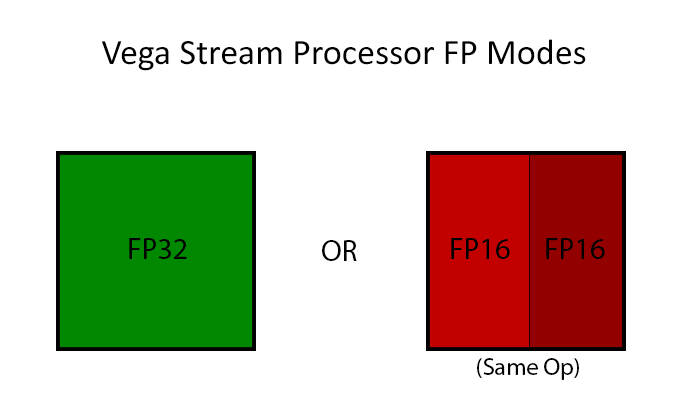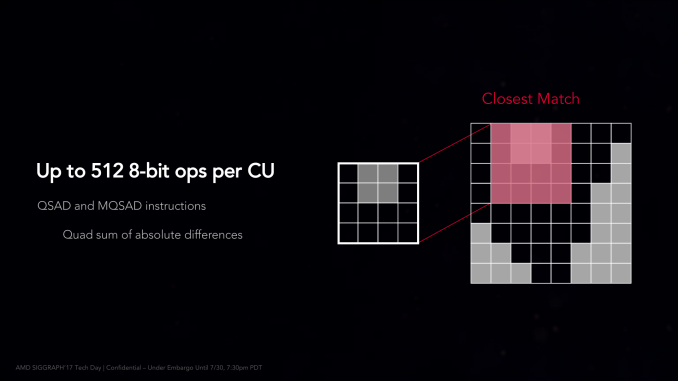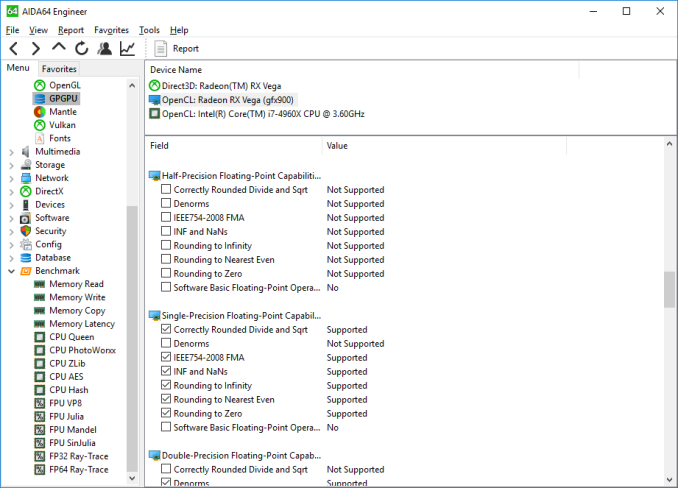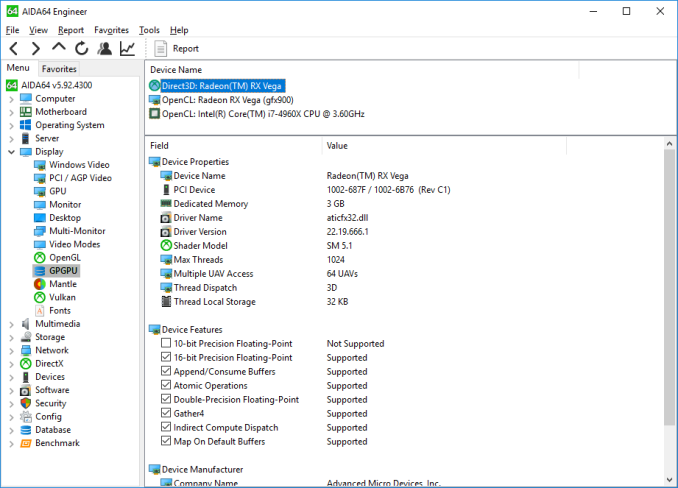The AMD Radeon RX Vega 64 & RX Vega 56 Review: Vega Burning Bright
by Ryan Smith & Nate Oh on August 14, 2017 9:00 AM ESTRapid Packed Math: Fast FP16 Comes to Consumer Cards (& INT16 Too!)
Arguably AMD’s marquee feature from a compute standpoint for Vega is Rapid Packed Math. Which is AMD’s name for packing two FP16 operations inside of a single FP32 operation in a vec2 style. This is similar to what NVIDIA has done with their high-end Pascal GP100 GPU (and Tegra X1 SoC), which allows for potentially massive improvements in FP16 throughput. If a pair of instructions are compatible – and by compatible, vendors usually mean instruction-type identical – then those instructions can be packed together on a single FP32 ALU, increasing the number of lower-precision operations that can be performed in a single clock cycle. This is an extension of AMD’s FP16 support in GCN 3 & GCN 4, where the company supported FP16 data types for the memory/register space savings, but FP16 operations themselves were processed no faster than FP32 operations.
The purpose of integrating fast FP16 and INT16 math is all about power efficiency. Processing data at a higher precision than is necessary unnecessarily burns power, as the extra work required for the increased precision accomplishes nothing of value. In this respect fast FP16 math is another step in GPU designs becoming increasingly min-maxed; the ceiling for GPU performance is power consumption, so the more energy efficient a GPU can be, the more performant it can be.
Taking advantage of this feature, in turn, requires several things. It requires API support and it requires compiler support, but above all it requires code that explicitly asks for FP16 data types. The reason why that matters is two-fold: virtually no existing programs use FP16s, and not everything that is FP32 is suitable for FP16. In the compute world especially, precisions are picked for a reason, and compute users can be quite fussy on the matter. Which is why fast FP64-capable GPUs are a whole market unto themselves. That said, there are whole categories of compute tasks where the high precision isn’t necessary; deep learning is the poster child right now, and for Vega Instinct AMD is practically banking on it.
As for gaming, the situation is more complex still. While FP16 operations can be used for games (and in fact are somewhat common in the mobile space), in the PC space they are virtually never used. When PC GPUs made the jump to unified shaders in 2006/2007, the decision was made to do everything at FP32 since that’s what vertex shaders typically required to begin with, and it’s only recently that anyone has bothered to look back. So while there is some long-term potential here for Vega’s fast FP16 math to become relevant for gaming, at the moment it doesn’t do much outside of a couple of benchmarks and some AMD developer relations enhanced software. Vega will, for the present, live and die in the gaming space primarily based on its FP32 performance.
The biggest obstacle for AMD here in the long-term is in fact NVIDIA. NVIDIA also supports native FP16 operations, however unlike AMD, they restrict it to their dedicated compute GPUs (GP100 & GV100). GP104, by comparison, offers a painful 1/64th native FP16 rate, making it just useful enough for compatibility/development purposes, but not fast enough for real-world use. So for AMD there’s a real risk of developers not bothering with FP16 support when 70% of all GPUs sold similarly don’t support it. It will be an uphill battle, but one that can significantly improve AMD’s performance if they can win it, and even more so if NVIDIA chooses not to budge on their position.
Though overall it’s important to keep in mind here that even in the best case scenario, only some operations in a game are suitable for FP16. So while FP16 execution is twice as fast as FP32 execution on paper specifically for a compute task, the percentage of such calculations in a game will be lower. In AMD’s own slide deck, they illustrate this, pointing out that using 16-bit functions makes specific rendering steps of 3DMark Serra 20-25% faster, and those are just parts of a whole.
Moving on, AMD is also offering limited native 8-bit support via a pair of specific instructions. On Vega the Quad Sum of Absolute Differences (QSAD) and its masked variant can be executed on Vega in a highly packed form using 8-bit integers. SADs are a rather common image processing operation, and are particularly relevant for AMD’s Instinct efforts since they are used in image recognition (a major deep learning task).
Finally, let’s talk about API support for FP16 operations. The situation isn’t crystal-clear across the board, but for certain types of programs, it’s possible to use native FP16 operations right now.
Surprisingly, native FP16 operations are not currently exposed to OpenCL, according to AIDA64. So within a traditional AMD compute context, it doesn’t appear to be possible to use them. This obviously is not planned to remain this way, and while AMD hasn’t been able to offer more details by press time, I expect that they’ll expose FP16 operations under OpenCL (and ROCm) soon enough.
Meanwhile, High Level Shader Model 5.x, which is used in DirectX 11 and 12, does support native FP16 operations. And so does Vulkan, for that matter. So it is possible to use FP16 right now, even in games. Running SiSoftware’s Sandra GP GPU benchmark with a DX compute shader shows a clear performance advantage, albeit not a complete 2x advantage, with the switch to FP16 improving compute throughput by 70%.
However based on some other testing, I suspect that native FP16 support may only be enabled/working for compute shaders at this time, and not for pixel shaders. In which case AMD may still have some work to do. But for developers, the message is clear: you can take advantage of fast FP16 performance today.
















213 Comments
View All Comments
BrokenCrayons - Monday, August 14, 2017 - link
The hypothetical APU that contains Zen, Polaris/Vega, and HBM2 would be interesting if AMD can keep the power and heat down. Outside of the many cores Threadripper, Zen doesn't do badly on power versus performance so something like 4-6 CPU cores plus a downclocked and smaller GPU would be good for the industry if the package's TDP ranged from 25-95W for mobile and desktop variants.By itself though, Vega is an inelegant and belated response to the 1080. It shares enough in common with Fiji that it strikes me as an inexpensive (to engineer) stopgap that tweaks GCN just enough to keep it going for one more generation. I'm hopeful that AMD will have a better, more efficient design for their next generation GPU. The good news is that with the latest product announcements, AMD will likely avoid bankruptcy and get a bit healthier looking in the near term. Things were looking pretty bad for them until Ryzen's announcement, but we'll need to see a few more quarters of financials that ideally show a profit in order to be certain the company can hang in there. I'm personally willing to go out on a limb and say AMD will be out of the red in Q1 of FY18 even without tweaking the books on a non-GAAP basis. Hopefully, they'll have enough to pay down liabilities and invested in the R&D necessary to stay competitive. With process node shrinks coming far less often these days, there's an several years' long opening for them right now.
TheinsanegamerN - Monday, August 14, 2017 - link
" It shares enough in common with Fiji that it strikes me as an inexpensive (to engineer) stopgap that tweaks GCN just enough to keep it going for one more generation. "We thought the same thing about polaris. I think the reality is that AMD cannot afford to do a full up arch, and can only continue to tweak GCN in an attempt to stay relevant.
They still have not done a Maxwell-Esq redesign of their GPUs streamlining them for consumer use. They continue to put tons of compute in their chips which is great, but it restricts clock rates and pushes power usage sky high.
mapesdhs - Monday, August 14, 2017 - link
I wonder if AMD decided it made more sense to get back into the CPU game first, then focus later on GPUs once the revenue stream was more healthy.Manch - Tuesday, August 15, 2017 - link
Just like there CPU's it's a jack of all trades design. Cheaper R&D to use one chip for many but you got to live with the trade offs.The power requirement doesn't bother me. Maybe after the third party customs coolers, I'll buy one if it's the better deal. I have a ventilated comm closet. All my equipment stays in there, including my PCs. I have outlets on the wall to plug everything else into. Nice and quiet regardless of what I run.
Sttm - Monday, August 14, 2017 - link
That Battlefield 1 Power Consumption with Air, is that actually correct? 459 watts.... WTF AMD.Aldaris - Monday, August 14, 2017 - link
Buggy driver? Something is totally out of whack there.Ryan Smith - Monday, August 14, 2017 - link
Yes, that is correct.I also ran Crysis 3 on the 2016 GPU testbed. That ended up being 464W at the wall.
haukionkannel - Monday, August 14, 2017 - link
Much better than I expected!Nice to see competition Also in GPU highend. I was expecting the Vega to suffer deeply in DX11, but it is actuallu doing very nice in those titles... I am really surpriced!
Leyawiin - Monday, August 14, 2017 - link
A day late and a dollar short (and a power pig at that). Shame. I was hoping for a repeat of Ryzen's success, but they'll sell every one they make to miners so I guess its still a win.Targon - Monday, August 14, 2017 - link
I would love to see a proper comparison between an AMD Ryzen 7 and an Intel i7-7700k at this point with Vega to see how they compare, rather than testing only on an Intel based system, since the 299X is still somewhat new. All of the Ryzen launch reviews were done on a new platform, and the AMD 370X is mature enough where reviews will be done with a lot more information. Vega is a bit of a question mark in terms of how well it does when you compare between the two platforms. Even how well drivers should have matured in how well the 370X chipset deals with the Geforce 1080 is worth looking at in my opinion.I've had the thought, without resources, that NVIDIA drivers may not do as well on an AMD based machine compared to an Intel based machine, simply because of driver issues, but without a reasonably high end video card from AMD, there has been no good way to do a comparison to see if some of the game performance differences between processors could have been caused by NVIDIA drivers as well.